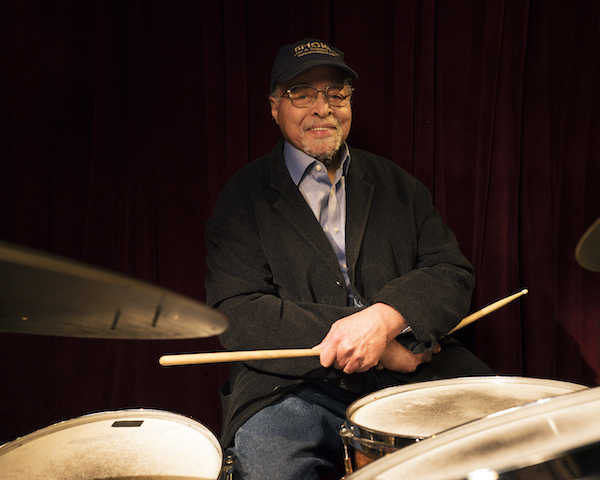Jun 3, 2025 11:25 AM
In Memoriam: Al Foster, 1943–2025
Al Foster, a drummer regarded for his fluency across the bebop, post-bop and funk/fusion lineages of jazz, died May 28…

Jimmy Cobb (1929–2020)
(Photo: Jimmy Katz)Drummer Jimmy Cobb—famous for a discography that includes appearances on numerous Miles Davis albums, including 1959’s Kind Of Blue—died in his Manhattan home May 25 from lung cancer, according to WBGO. He was 91.
Cobb was a member of Davis’ band between 1957 and 1963, and appeared on several of the trumpeter’s albums, including, among others, Porgy And Bess (1959), Sketches Of Spain (1960), Miles Davis In Person: Friday Night At The Blackhawk (1961) and Miles Davis At Carnegie Hall (1962).
Following his stint with Davis, Cobb worked in pianist Wynton Kelly’s namesake trio with bassist Paul Chambers. (Kelly and Chambers had been in Davis’ band, too.)
A tasteful drummer known for his pulse and groove—who eschewed showy grandstanding—Cobb was comfortable being in the role of accompanist. It was a quality that made him a sought-after collaborator for decades.
During a career that began in the late 1940s, Cobb performed with the biggest names of the genre. A partial list of collaborators illustrates a wide span of musical history: Billie Holiday, Charlie Parker, Dizzy Gillespie, John Coltrane, Clark Terry, Sarah Vaughan, Cannonball Adderley, Wes Montgomery, Dinah Washington, Ron Carter, Nancy Wilson, Wayne Shorter, Brad Mehldau, Roy Hargrove and Christian McBride.
A native of Washington, D.C., James Wilbur Cobb was born Jan. 20, 1929. When he began playing drums as youngster, his key influences included Max Roach and Kenny Clarke.
Cobb’s leader projects included Only For The Pure Of Heart (1998), Cobb’s Corner (2007) and The Original Mob (2014). In 2019, Smoke Sessions released his album This I Dig Of You, recorded with guitarist Peter Bernstein, pianist Harold Mabern and bassist John Webber.
In an article by Ted Panken in the September 2019 issue of DownBeat, Cobb described how he devised the insistent ride-cymbal sound for which he became famous.
“I developed it from not having something else,” he said. “Once, on a gig with Dizzy Gillespie, I was playing a coordination thing out of Jim Chapin’s book with figures he’d heard guys play without the bass drum being in 4, as guys had done in the big bands, so that everyone could hear the beat. Dizzy probably was used to hearing his guys play that way, and he came over and put his ear down by the bass drum. I told him, ‘Well, Birks, I don’t have a big 4/4 like that.’ I had to have the beat somewhere, so I concentrated on making it heard on the cymbal. I always liked the way Kenny Clarke played the cymbal—nice and quiet, but definite and killing—and I got some stuff from him.”
As a clinician, Cobb taught at numerous institutions, including the Stanford Jazz Workshop, The New School for Jazz and Contemporary Music, the University of Greensboro in North Carolina and the International Center for the Arts at San Francisco State University.
When Cobb was named a 2009 NEA Jazz Master fellowship recipient, he issued this statement: “I am humbled to be included among the great musicians in our American history. I express my gratitude to these jazz giants, many of whom were close friends, who shaped this great American art form called jazz and ultimately helped to shape my life as well. I thank the NEA committee for recognizing America’s jazz masters and the art of jazz itself and I am honored and privileged to be a part of this legacy.”
Survivors include his wife and two daughters. DB

Foster was truly a drummer to the stars, including Miles Davis, Sonny Rollins and Joe Henderson.
Jun 3, 2025 11:25 AM
Al Foster, a drummer regarded for his fluency across the bebop, post-bop and funk/fusion lineages of jazz, died May 28…

“Branford’s playing has steadily improved,” says younger brother Wynton Marsalis. “He’s just gotten more and more serious.”
May 20, 2025 11:58 AM
Branford Marsalis was on the road again. Coffee cup in hand, the saxophonist — sporting a gray hoodie and a look of…

“What did I want more of when I was this age?” Sasha Berliner asks when she’s in her teaching mode.
May 13, 2025 12:39 PM
Part of the jazz vibraphone conversation since her late teens, Sasha Berliner has long come across as a fully formed…

Roscoe Mitchell will receive a Lifetime Achievement award at this year’s Vision Festival.
May 27, 2025 6:21 PM
Arts for Art has announced the full lineup for the 2025 Vision Festival, which will run June 2–7 at Roulette…

Benny Benack III and his quartet took the Midwest Jazz Collective’s route for a test run this spring.
Jun 3, 2025 10:31 AM
The time and labor required to tour is, for many musicians, daunting at best and prohibitive at worst. It’s hardly…